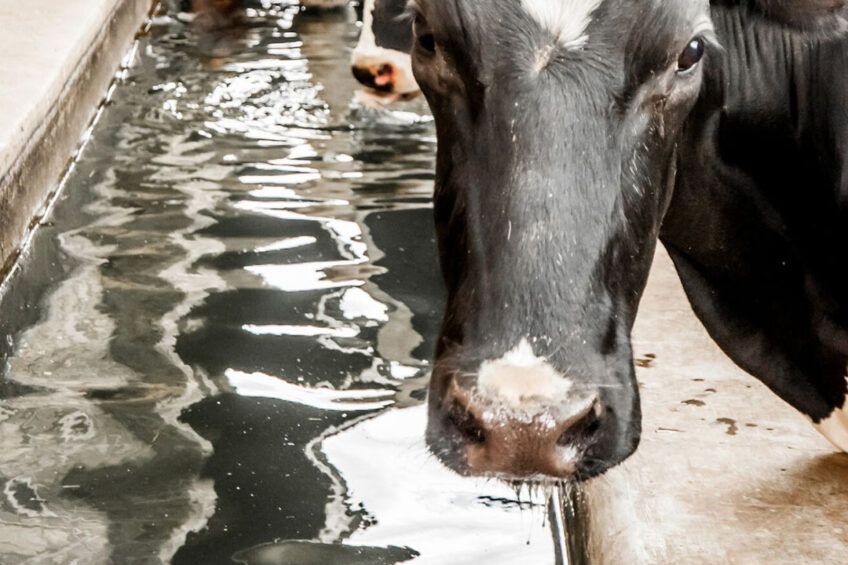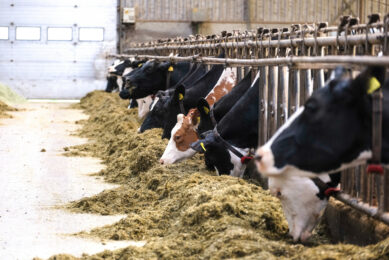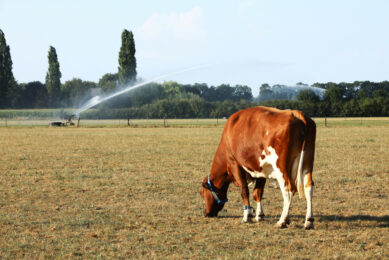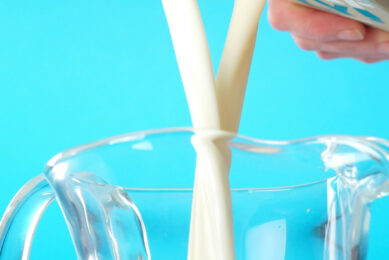High-producing lactating cows and heat stress

Researchers have investigated the impact of heat stress in Australian dairy cows grazing summer pastures, seeing high temperatures and humidity leading to a significant drop in milk production – but this can be rectified.
Led by The University of Melbourne and Ghana, researchers at the Faculty of Veterinary and Agricultural Sciences investigated the effect of summer heat on lactating Holstein Friesian cows at the university’s robotic milking farm in Dookie, Victoria, Australia.
According to the study, moderate to high ambient temperature and relative humidity compromise the ability of dairy cattle to maintain homeothermy and, when the core body temperature is increased above the normal physiological level, heat stress occurs.
In dairy cattle, heat stress causes negative impacts on feed intake and milk production, but also on growth and welfare, reproduction performance, health status and immune responses. This results in a significant financial burden to the dairy industry.
In dairy cows, milk production has been reported to decline by 17-53% and feed intake by 35-48% because of heat stress. Low fertility was also recorded. Additionally, conception rates from artificial insemination vary from 55% to less than 10% during the months of low and high temperatures and humidity, respectively.
Lactating cattle
The objective of the study was to measure the impacts of summer heat events on physiological parameters such as body temperature, respiratory rate and panting scores, grazing behaviour and production parameters of lactating Holstein Friesian cows managed on an automated robotic dairy during Australian summer. A number of different non-invasive tests were undertaken to monitor the cows during the summer period.
High-producing lactating cattle are most susceptible to heat stress due to their relatively high increment of metabolic heat and continued selection for high production, which has negative impacts on cow welfare and productivity, with variations in individual cow ability to tolerate this stress.
The experiment, which was carried out during summer, used 120 healthy Holstein Friesian cows in early to late lactation. The ambient temperature ranged from 18-42°C, and the relative humidity ranged from 25-75%. The experiment took place at the University of Melbourne Dookie Campus.
Mean monthly maximum in the temperature-humidity index (THI) – a single value representing the combined effects of air temperature and humidity associated with the level of thermal stress – ranged from 76-81 during the 3 summer months of the experiment. Lactating cows respired significantly faster and panted relatively more frequently under the high temperatures. The average surface body temperature of lactating cows as measured by infrared thermometry followed a similar trend.
Global warming
The results show that high temperature-humidity conditions led to a significant drop in milk production as most cows stopped grazing, sought shade, panted and spent more time at watering points. Per cow, with increasing THI, production went down to 22 kg under high THI (≥83).
On the other hand, milk temperature significantly increased with increasing THI. In terms of milk composition, both average fat and protein percentages were significantly higher at high THI. The cows, on average, also consumed less concentrate as THI increased.

Heat stress includes not only heat from the environment but also metabolic heat, which is produced by the cow to support body functions, the researchers emphasise. High-producing lactating dairy cattle tend to be more sensitive to heat stress because of their increased metabolic heat production, which is a result of their higher feeding requirements to support high milk yield.
The researchers say the rise in temperatures due to global warming is putting increased pressure on Australia’s livestock industry, as animals are increasingly exposed to warmer and more humid weather. This also represents an animal welfare issue that researchers are keen to improve.
Little time grazing
The behaviour of the cows was also observed during the study period. Cows that had grazed comfortably in early summer exhibited signs of distress and open-mouth panting during a heat event at the peak of summer.
In addition, most of the cows spent more time at the watering points and very little time grazing during heat events. At the peak of the heat events, the less thermotolerant cows – that is, those that have the ability to tolerate heat – spent the majority of time in the water troughs, while other cows were struggling or waiting for the chance to get into available water troughs.
University of Melbourne lead researcher, Dr Surinder Chauhan, says that while the research indicates that over summer months cows can experience severe heat stress, there are actions that farmers can take to improve livestock welfare, such as providing shade and water for the cows to cool down.
The Dookie robotic dairy farm, where the experiment took place, is a modern farm with some heat-mitigating facilities to ensure cow comfort during heat events. Shade is provided by trees, and sprinklers and misting fans have been installed in the robotic milking parlour for the cows during the summer months.
Despite all these facilities, the researchers observed cows suffering from heat stress, indicating that current environmental mitigating strategies on most dairy farms may not be adequate to completely solve the problem of heat stress during summer.
Genetic selection
This also confirms earlier findings that, even on well-cooled dairies or in temperate areas, heat stress decreases milk yield by 10-15% and, on non-cooled management systems, milk yield can decrease by as much as 40-50%. This can be partially attributed to the reduction in feed intake and changes in post-absorptive metabolism as a result of heat stress. It is also plausibly due to the significant negative association between THI and milk production.
Chauhan says that previous research by the University of Melbourne has shown that continuous genetic selection of dairy cows for improved feed intake and higher milk yield may also affect the heat tolerance of cows with negative association between thermotolerance and production traits.
University of Melbourne’s head of the School of Agriculture and Food Systems, Professor Brian Leury, says that the research represented an important collaboration between the University of Melbourne and partners in Africa.
“We are very thankful for the expertise brought by co-author Richard Osei-Amponsah and hope to continue studies across Africa and Australia to investigate which breeds of cow are better adapted to warmer climates,” he said.
Join 13,000+ subscribers
Subscribe to our newsletter to stay updated about all the need-to-know content in the dairy sector, two times a week.










